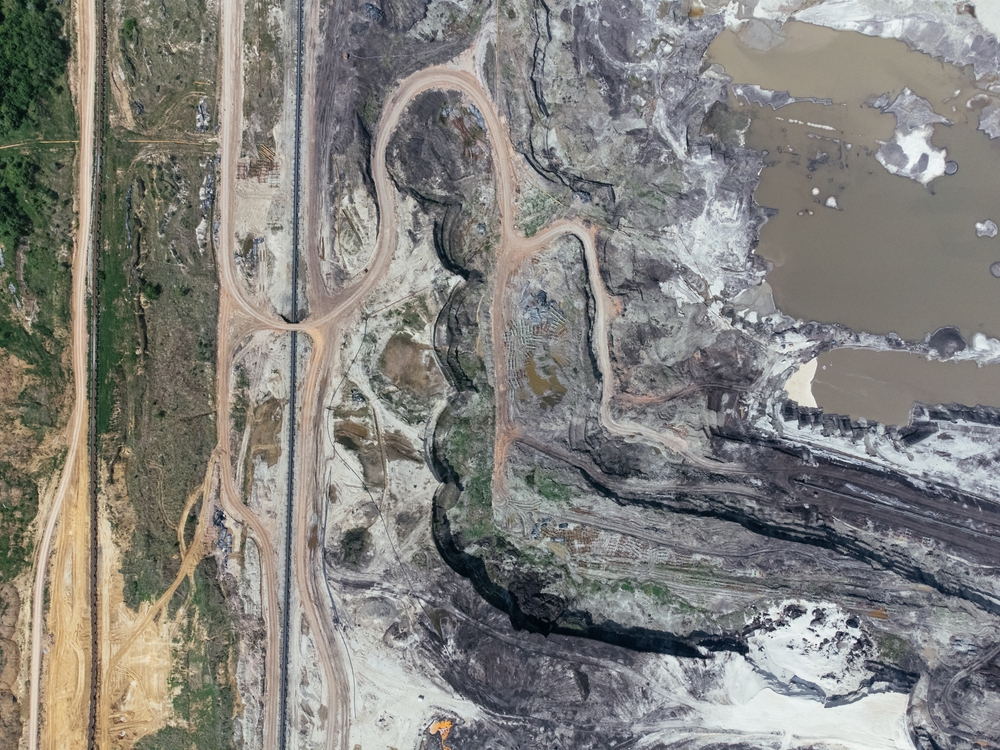A long way to go: the Western Balkans and the green transition
To eventually access the European Union, the Western Balkans have to align their legislation with EU law. This includes the Green Deal, which commits countries to net zero greenhouse gas emissions by 2050. However, there’s still quite a long way to go for the Western Balkans in their progress towards the green transition.

Coal mining in Lazarevac, Serbia (photo © Artem Onoprienko/Shutterstock)
Except for Kosovo, all the Western Balkans are now EU candidate countries. As the requirement for becoming a member of the European Union is the implementation of the EU legislation, the countries need to abide by the European Climate Law of 2021 which requires a 55 percent reduction of greenhouse gas emissions by 2030 compared to 1990 levels.
At the first glance, the Western Balkan’s total greenhouse gas emissions (GHG) raise hopes. Except for Serbia, which ranks 13th highest overall emitter among European countries, the Western Balkans’ emissions are significantly lower than those of most EU members, as the map shows.
But total emissions are only one part of the story. It is not surprising that countries that are relatively poorer, smaller, or less inhabited than others generate less emissions. However, if we consider the GHG emissions relative to the size of the countries’ economies – that is, the amount of emissions per million dollars in GDP – the Western Balkans turn out to be among the highest polluters in Europe. In particular Serbia and Bosnia and Herzegovina stand out as the highest emitters per GDP. For instance, while the Serbian economy is similar in size to Lithuania’s, it emits over three times the amount of GHG compared to it. Albania is the only exception in the region, having an emission intensity comparable to many Eastern members of the EU.
Emission-intense economies
The emission intensity of an economy depends on the types of energy sources used, on energy efficiency, and on the country’s economic structure. A report of the OECD shows that the reason for the Western Balkans’ emission intensity is mainly due to the low energy efficiency and their energy sources.
The low energy efficiency is especially visible in buildings, which on average account for 40 percent of the Western Balkans’ total energy consumption. They consume a high amount of energy, as the insulation is often inadequate and the heating systems inefficient, with two-thirds of the households still relying on wood and coal for heating in winter. BiH’s and Serbia’s energy intensity – an indicator measuring the energy supply per unit of GDP – is thus up to three times higher than in most EU countries. An additional problem is the energy infrastructure, which is fragmented and outdated, resulting in significant energy losses, thereby increasing the need for an even higher energy production. Lejla Hukić, Project Coordinator at the Bosnian NGO Forestry and Environmental Action, points out that technical issues such as the “improvement of transmission grids and development of energy storage” are key challenges for the greening of the country’s energy supply.
Besides the low energy efficiency, the region’s energy mix is heavily dominated by coal. The fossil fuel accounts for around 70 percent of the Western Balkans’ electricity production. The exception is Albania, which relies almost exclusively on hydropower, which largely explains the country’s relatively low emission intensity. What’s more, the type of coal that is used in the region is lignite, which is an especially polluting type with a low caloric value, meaning that burning more lignite is needed to produce the same amount of energy as from other types of coal. However, lignite is a cheap source of energy that makes the countries less dependent on energy imports as it is abundantly available in the region. The result is that the sixteen operating coal power plants in the region are more polluting than other coal plants in Europe. In 2016 alone, 3,900 premature deaths were attributed to these sixteen plants, according to the 2019 report of CEE Bankwatch.
The trajectory: Green Agenda for the Western Balkans
After long having lacked a concrete plan to reduce emissions, the governments of the Western Balkan countries signed the Green Agenda for the Western Balkan (GAWB) in 2020, supported by the EU. The Green Agenda mirrors the EU’s Green Deal and shares the goal to achieve carbon-neutrality by 2050 and reduce emissions by at least 55 percent compared to 1990 levels by 2030. Consisting of five pillars, the agenda requires an alignment with the EU Climate Law and thereby a reduction of the GHG emissions, for example through shifting towards renewables and developing the rail system. The GAWB Action Plan concretizes the measures to be taken to achieve the goals.
So far, NGOs criticize that the countries lag behind in the implementation of new climate legislation to align with the EU. To reach decarbonization by 2050, the energy intensity and the carbon intensity of the economy must fall. Energy intensity in Montenegro, North Macedonia and Albania has started to show a downward trend, meaning that each unit of economic output needs less energy than before. This trend is called decoupling, which implies that an increase in GDP does not lead to an equal increase in emissions. A country can decouple by either using less energy per unit of GDP – what is shown in the chart below – or produce less emissions by using renewable sources of energy like solar instead of coal. As the graph indicates, Serbia and Bosnia and Herzegovina are still very energy intensive. Despite some progress, also most European countries are still far from an absolute decoupling. Hence, more work needs to be done to decarbonize the economies by 2050.
Decarbonization to remain competitive
One policy measure foreseen in the GAWB Action Plan until the end of 2024 is to introduce a price for carbon, which is the key idea behind the EU Emissions Trading System (ETS). Thus far, the Western Balkans are not part of the ETS, meaning that their exports to the EU are cheaper compared to energy and goods produced in the EU under the ETS. That’s why the EU will introduce a Carbon Border Adjustment Mechanism in 2026. The principle behind it is that products from non-EU countries that are exported to the EU must be subject to an extra tax for the greenhouse gasses that were generated during their production.
To quantify the emissions and thereby the amount to be paid under this scheme, companies in the Western Balkans will be obliged to start reporting their emissions from October 2023 onwards. According to 2020 estimates, the emissions of the Western Balkans would be priced at €1.2 billion overall – with rising CO2 prices, this would increase further. Hence, the Western Balkans need to decarbonize to remain competitive with the EU. This makes the implementation of the Green Agenda all the more relevant.
“Political will is missing”
However, NGOs from the region have criticized the lack of action to reach the commitments that were made. Multiple NGOs signed an open letter of the Climate Action Network ahead of a meeting between EU and Western Balkan leaders in 2022, which pointed out that the current investment proposals contribute to “maintaining the fossil fuel status quo in the region.”
Phasing out of coal is a social and economic challenge for the heavily fossil fuel reliant Western Balkans. Hence, stronger stakeholder engagement is necessary, says Milka Gvozdenovic, environmental sector manager in Young Researchers of Serbia. According to him, the crucial coal phase-out lacks action. “When we look at the facts, actions, and everyday decisions, it is clear that political will is missing.” Both Serbia and Bosnia and Herzegovina still plan the construction of new coal plants. And despite Serbia’s adoption of a Climate Change Law in 2021, Gvozdenovic criticizes that “there are no visible changes due to the law. Climate change bylaws are still missing. Until 2023, only three bylaws were adopted, while more than fifteen are lacking and without them the Climate Change Law cannot be implemented properly. The deadline for adoption of all bylaws expired in March 2022.” In his opinion, a main obstacle to Serbia’s green transition is the lack of transparency and public participation. Even though the challenges to decarbonization vary across the Western Balkan countries, a report of the Friedrich-Ebert-Stiftung shows that all countries struggle with a lack of the rule of law and a lack of capacity to implement rules.
But Lejla Hukić from the Bosnian NGO Forestry and Environmental Action remains optimistic. Recent legislation, for example Bosnia and Herzegovina’s Framework Energy Strategy, “reflect the shared commitment to increase the use of renewable energy sources and improve energy efficiency,” says the Project Coordinator. Hukić believes that “there is generally an interest of the governments in implementing the Green Agenda in the Western Balkans.”
However, she points out that “access to financing and international collaboration” is needed for a successful green transition. The Green Agenda is accompanied by an investment plan that promises €9 billion in investments by the EU, which should mobilize a total of €20 billion in investments into the region. A first €1.8 billion in grants have already been approved. Most of the approved projects focus on the construction of roads and railway systems, followed by investments into clean energy. This includes not only solar energy but also several hydropower projects across the region, some of which are controversial. And even with such investments, the transition towards full decarbonization will take more effort and time.
Original source: https://www.balcanicaucaso.org/aree/Bosnia-Erzegovina/I-Balcani-occidentali-e-la-transizione-verde-una-lunga-strada-225788
